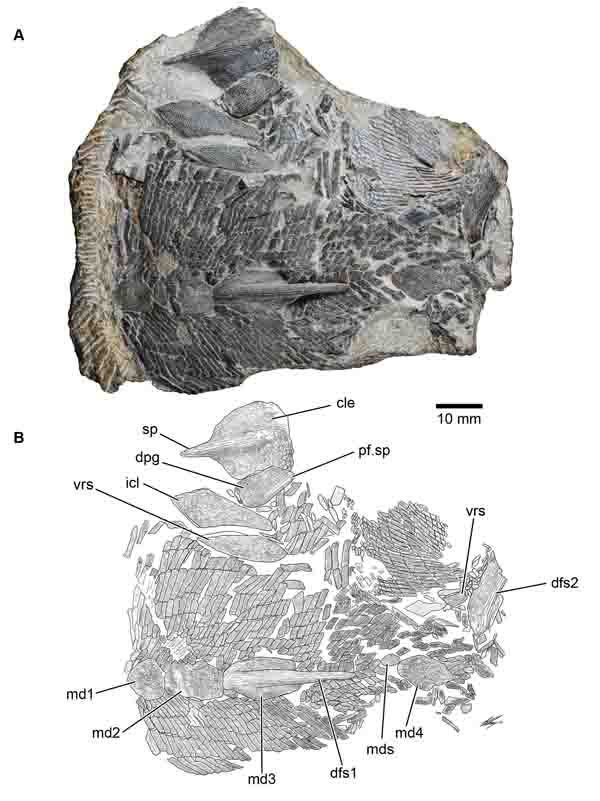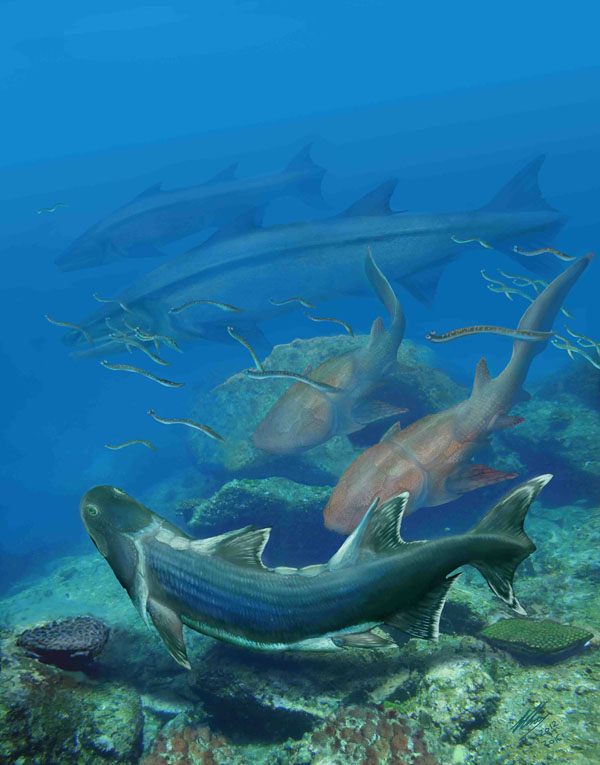Zhu Min’s team at the Institute of Vertebrate Paleontology and Paleoanthropology, Chinese Academy of Sciences has made new progress in the field of early vertebrate animal research. On March 8, the magazine "PLOS ONE" reported the latest scientific research results of Dr. Chu Bulan and others. They described an ancient fish with strange scales 420 million years ago, Onychophora dinii, which provides new fossil evidence for exploring the early differentiation of jawed vertebrates and the origin of bony fishes. As a new member of the Silurian Xiaoxiang vertebrate fauna, Onychophora further supports that Qujing, Yunnan, was the early differentiation center of jawed vertebrates, indicating that the earth had already entered the "fish phase" as early as the Silurian Period (444-419 million years ago). era". After the dreamy ghost fish, the Onychophora dinii becomes the second relatively completely preserved Silurian bony fish.
Sparalepis tingi is unique in that its body is covered with thick and tightly jointed scales, like a warrior wearing armor. The genus name means that its scales resemble the rectangular shield made of woven wicker held by ancient Persian infantrymen, and the species name is dedicated to Mr. Ding Wenjiang (1887-1936), the namer of the Silurian section in Qujing, Yunnan and one of the founders of Chinese geology. ).
Bony fishes are the backbone of jawed vertebrates and are divided into two major branches: lobe-finned fishes and ray-finned fishes. The lobe-finned fish evolved into later tetrapods (amphibians, reptiles, birds and mammals), while the lobe-finned fish that remained in the water are now the only ones left with a few lungfish and coelacanths. Ray-finned fish still live in the water. Most of our common fish (green, grass, silver carp, bighead carp, etc.) belong to this group, and there are more than 30,000 species. Therefore, the early differentiation of jaws and the origin and early differentiation of bony fishes occupy a very important position in the evolutionary history of vertebrates.
However, until the end of the last century, fossils of early bony fishes were still very rare, and most of them were scattered fossils. Due to the absence of transitional fossils, a large morphological gap exists between lobe-finned fishes and ray-finned fishes, and between bony fishes and other jawed fishes. In the past nearly 20 years, the discovery of many exquisite fossils from the Xitun vertebrate fauna of the Early Devonian in Yunnan (such as the squid, the ostrich, the miman, etc.) has gradually narrowed these gaps. The Xiaoxiang vertebrate fauna is unique in the world in that it has preserved a large number of Silurian gnathostome fossils, such as holognathus and unignathus discovered in recent years, which has opened a new door for exploring the rise of gnathostomes. window.
Like the ghost fish and the spotted fish, the armored fish has a membranous bone belt and shoulder straps supported by spines. This was once considered a unique feature of placoderm fish. The limb girdle connects the limb bones to the axial bones. The two are collectively called appendicular bones and are important movement organs. Among living vertebrates, the front shoulder girdle has both membranous skeleton and endoskeletal components, while the posterior girdle only has endoskeletal components. The two are clearly distinguished. However, fossil data show that the belt and shoulder girdle of placoderms and some early bony fishes have very similar structures, and are also composed of membranous skeleton and endoskeleton, indicating that the belt and shoulder girdle may have close developmental modules. The emergence of onychophorans provides new fossil evidence for this hypothesis.
The armored fish is covered with very special diamond-shaped scales. These scales are similar to the scales of early bony fishes such as ghost fish and spotted fish, but there are obvious differences. Overall, the height of the scales on the side gradually decreases from front to back, but it is not as dramatic as that of the ghost fish. There are about 30 rows of scales covering the front of the first dorsal fin, twice as many as the ghost fish (about 15 rows). The scales are thicker and have a prominent neck that divides the scales into a crown and a base, which is similar to the spotted fish but different from the ghost fish. The scale crown has nearly parallel ridge-like patterns with no holes between the patterns, a feature similar to that of ghost fish. On the scales on the front side, the concave dorsal side and the convex ventral side, as well as the squamous articular process and the squamous glenoid fossa form joint structures. The covered pressure area on the crown of the scales is not obvious, unlike the obvious imbricated arrangement of ghost fish and spotted fish.
Phylogenetic analysis shows that onychophorans, ghost fish, spotted fish and imperforate fish all belong to the stem group of lobe-finned fishes. They have characteristics of early bony fish, but also have shoulder girdle, girdle, and dorsal fin spines similar to those of placoderms, and membranous bones of the head similar to holognathus. This combination of characteristics bridges the morphological gap between early bony fishes and other jawed fishes, and between lobe-finned fishes and ray-finned fishes, and also indicates that a branch of placoderms may have evolved later. bony fish. The peculiar scale structure of the onychophorans suggests that early bony fishes were far more morphologically diverse than previously thought. With the continuous discovery of new materials on the Xiaoxiang vertebrate fauna, this evolutionary process will become increasingly clear.
Original link: http://journals.plos.org/plosone/article?id=10.1371/journal.pone.0170929

Figure 1. Holotype fossil of Onychophora dinii (photo provided by Zhu Min)

Figure 2. Ecological restoration map of Onychophora dinii (photo provided by Zhu Min)
animal tags: fish fossil evolution
We created this article in conjunction with AI technology, then made sure it was fact-checked and edited by a Animals Top editor.